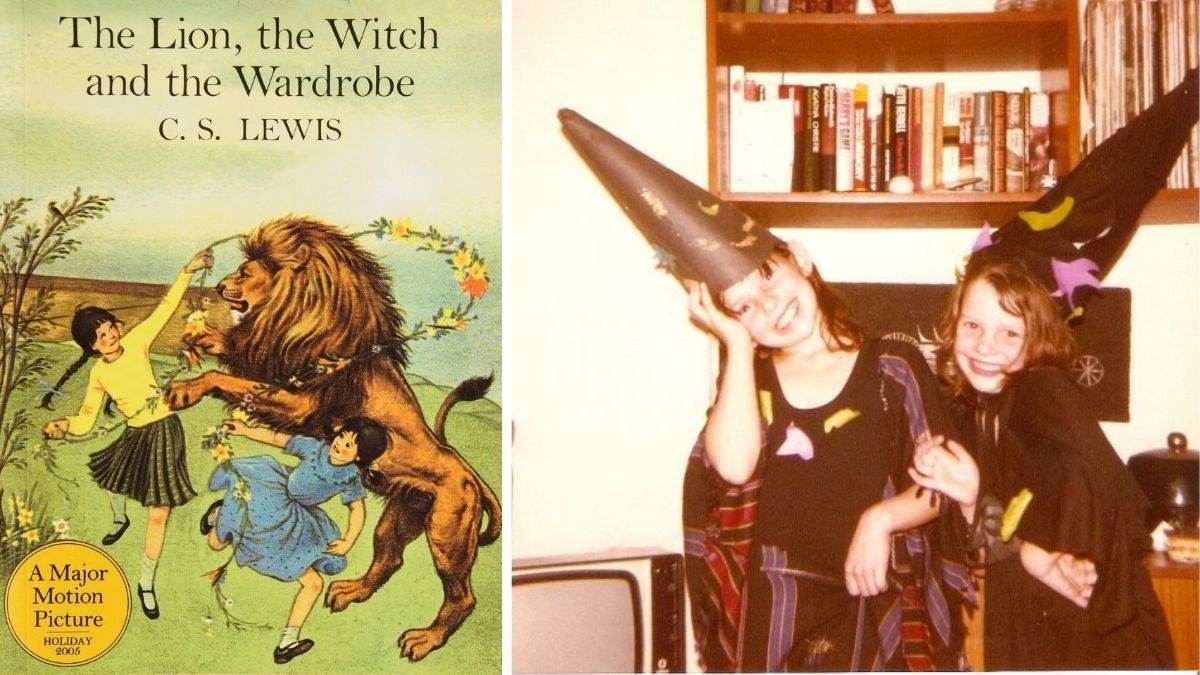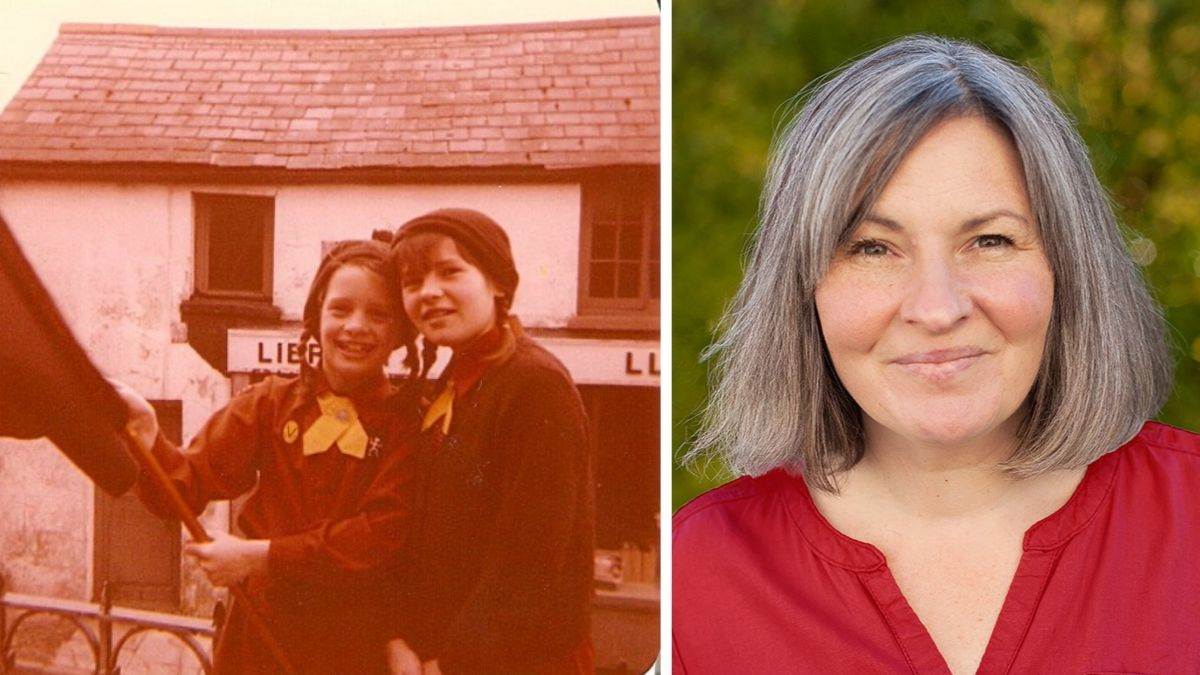The Book That Made Me: Eloise Williams
Published on: 13 Hydref 2020
Mysterious fauns, regal lions, and terrifying witches... C.S. Lewis' fantasy tale The Lion, The Witch and The Wardrobe has become legendary. Wilde author and Welsh Children's Laureate Eloise Williams explains what the magical world of Narnia meant to her as a child.
 Eloise Williams as a child and the cover of The Lion, The Witch and The Wardrobe
Eloise Williams as a child and the cover of The Lion, The Witch and The Wardrobe
Libraries are small heavens
When I was young, I lived opposite a library. I didn’t realise at the time what a privilege this was. I assumed in my cushioned childhood that all children had access to a thousand different worlds. That all children could cross the road on a whim and walk into adventure. Rather than one particular book, it is the library and my parents’ passion for taking me there and their enthusiasm for reading to me and with me, that made me.
Libraries are small heavens. Quiet places where nothing is expected of you other than to lose yourself in reading. I am made up of many books and most of them were rubber-stamped and dated by Val, our librarian, keeper of magic and lord of the realm. I’m not sure that Val actually realised just how pivotal a role she had.
Enid Blyton’s Famous Five mysteries, laced with mist and smugglers, kept me awake late into the torchlit night. Arthur Ransome’s Swallows and Amazons, where children pirated and sailed alone made me long for lakes and a boat of my own. The Worried Ghost – I had issues with anxiety even then and completely empathised with his state of mind – was a ghost who haunted a library! What could be better than that?
Everything strange and 'other'
I was drawn to legends and everything strange and ‘other’, folklore and myths, anything demanding courage and containing a puzzle to be solved. I would bravely ride through worlds on the library’s scarlet bucket chairs and know with certainty that children were smart and able to overcome the most terrifying of obstacles. They succeeded where adults stumbled. They could solve the mystery, find the key, feel and see the magic.
One book, at that time, was rubber-stamped and renewed to the point of being dog-eared and creased. The Lion, the Witch and the Wardrobe by C.S. Lewis. If there is anyone out there who hasn’t read or heard of the story, in brief, it’s about a group of children, the Pevensie siblings, who are evacuated to an old house in the country. One day, because of rainy conditions (which made it easy to identify with, being Welsh) the children are forced to entertain themselves indoors and decide to play hide and seek. The youngest, Lucy, hides in a wardrobe and discovers a parallel world at the back of it. Cue snow and a witch, talking animals and a curse that it will always be winter and never Christmas – unimaginably cruel for me as a child. Bring forth battles and a world where children become kings and queens. Delicious at the time! Unlike the featured Turkish Delight which I could never get a taste for, try hard as I might. Like thousands of other children, many now authors I’m sure, I searched the back of wardrobes and cupboards in everlasting hope.
It didn’t really matter that Narnia wasn’t there because I already owned it, imagined it, retold it, reinvented it, lived it in my imagination.
I didn’t see stories about young people in Wales back then, so I fitted Narnia into my Wales and mapped it out in my own landscape. I think that’s why the story has had such a lasting effect on me. Llantrisant forest was undoubtedly the Narnian forest. The place where my hill met the next was where Cair Paravel – the witch’s home lay. The house in the field opposite was the home of the professor and his study filled to the ceiling with books.
 Author Eloise Williams with a photo of herself as a child.
Author Eloise Williams with a photo of herself as a child.
A magic that belongs to us all
I still do this now, collect parts of the landscape to weave stories, certain that this stems from that particular reading experience. For my latest book, Wilde, a story about a witch – I have been going to write a witch story ever since The White Witch entered my psyche about forty years ago - I collected places to inspire the plot. The Sgwd-yr-Eira (Falls of Snow) waterfall became an integral cog. In the Brecon Beacons' National Park, it’s the only waterfall I’ve ever been to that you can stand behind and be lost inside a cathedral of cascading sound and light. Walking from our world into another, a parallel and very different world, just as the Pevensies did. I took the name of a place close to this waterfall, ‘Seven Sisters’ and transformed it into a legend of rivers and lost souls and a family with seven sisters. I used a curse, it was a witch trial and a heatwave rather than snow.
I used techniques I’d used when I was seven to bring my story to life.
I often tell children that The Lion, The Witch & The Wardrobe made my imagination grow from the size of a pea to the size of worlds and whilst it is of course a library of books which led to my love of stories, I believe this one has had the biggest impact. It taught me that a good tale can take you anywhere and that anything was possible. I’ve carried that belief beneath my skin from the day I first opened its cover and walked into those enchanted pages, snow-booted and ready to quest. It taught me that stories are a powerful kind of magic, a magic that belongs to us all, a magic that lasts a lifetime.
Eloise Williams is the Welsh Children's Laureate and author of Elen's Island, Gaslight, Seaglass, and Wilde. Follow her on Twitter here.
Topics: Adventure, Fairy tale, Fantasy, Classics, Features, The Book That Made Me
Waterstones Children's Laureate: Joseph Coelho
Poet Joseph Coelho is the Waterstones Children's Laureate for 2022-24.
The role of Children's Laureate is awarded once every two years to an eminent writer or illustrator of children's books to celebrate outstanding achievement in their field. Find out what Joseph's been up to.





